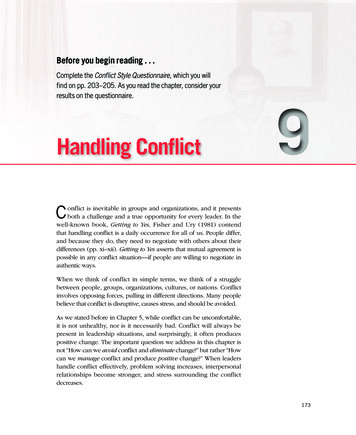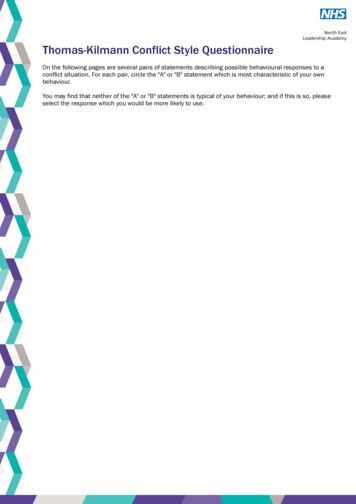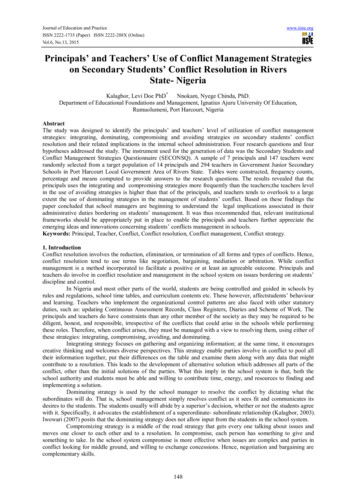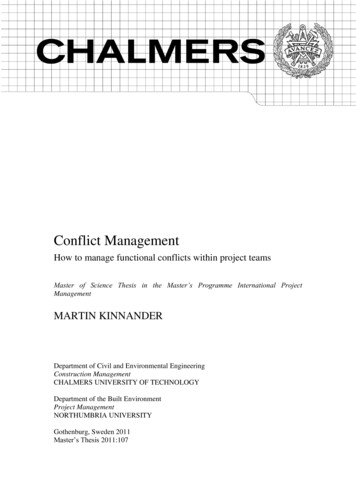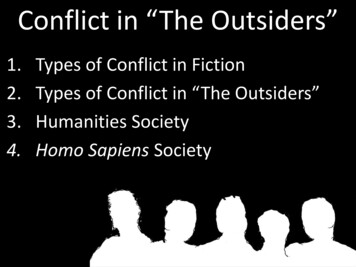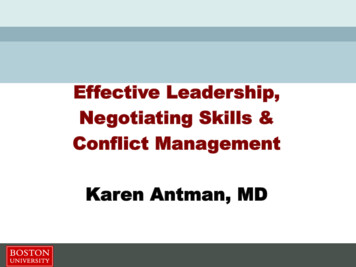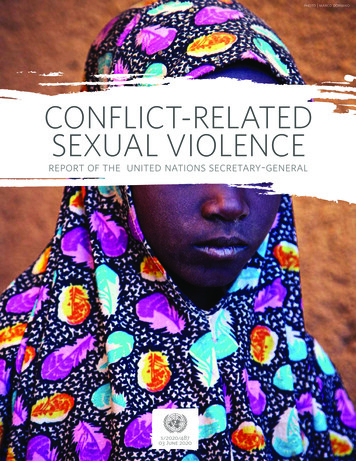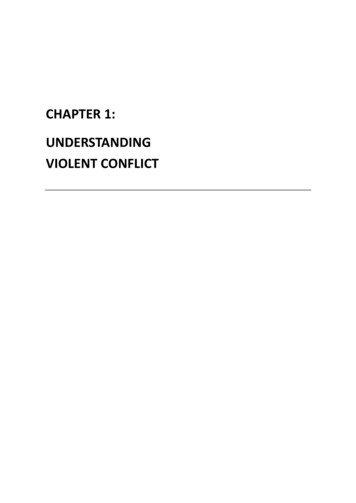
Transcription
CHAPTER 1:UNDERSTANDINGVIOLENT CONFLICT
The Causes of ConflictThe Causes of ConflictINTRODUCTION . 6POLITICAL AND INSTITUTIONAL FACTORS . 7IDENTITY POLITICS . 10SOCIOECONOMIC FACTORS . 11RESOURCE AND ENVIRONMENTAL FACTORS . 14IntroductionThere is no single cause of conflict. Rather, conflict is context-specific, multi-causal and multidimensional and can result from a combination of the following factors: Political and institutional factors: weak state institutions, elite power struggles andpolitical exclusion, breakdown in social contract and corruption, identity politicsSocioeconomic factors: inequality, exclusion and marginalisation, absence or weakening ofsocial cohesion, povertyResource and environmental factors: greed, scarcity of national resources often due topopulation growth leading to environmental insecurity, unjust resource exploitationEach of these factors may constitute a cause, dynamic and/or impact of conflict. New issues willarise during conflict which perpetuate the conflict. Identifying and understanding the interactionsbetween various causes, dimensions, correlates and dynamics of conflict – and the particularcontexts in which conflict arises, is essential in determining potential areas of intervention; anddesigning appropriate approaches and methods for conflict prevention, resolution andtransformation.The way in which a government or institution at an international or societal level addressesconflict between individuals, groups or nations can determine whether the parties to the conflictwill resort to violence.Ohlson, T., 2008, ‘Understanding Causes of War and Peace’, European Journal of InternationalRelations, Vol. 14, No. 1, pp. 133-160How are the causes of war and peace related? Is it possible to bridge the conceptual gap betweencauses-of-war theory and conflict resolution theory? This article puts forward a new conceptualframework to facilitate the analysis of the outbreak, conduct and resolution of armed conflictwithin states. This 'Triple-R' framework involves consideration of reasons, resources and resolvefor engaging in violence.Smith, D., 2004, ‘Trends and Causes of Armed Conflict’, Berghof Research Centre for ConstructiveConflict Management, BerlinThis chapter provides a brief overview of what is known and understood about the causes ofarmed conflict. The emphasis is on an applied methodology for studying and analysing armedconflict, rather than on theory. It looks at both the variety and the different types of causes ofarmed conflict. It introduces the conceptual pairing of justice and mobilisation as a way of linkingthe long and short term issues leading to conflict.See full textConflict: Topic Guide, revised 2014, GSDRC6
Chapter 1: Understanding Violent ConflictHoeffler, A., 2012, ‘On the Causes of Civil War’, In the Oxford Handbook of the Economies ofPeace and Conflict, Oxford University Press, OxfordWhat causes civil wars? This chapter provides an overview of the research looking into the causesof civil war and argues that the research on the causes of war is unlikely to be helpful for settlingcivil wars. Irrespective of the original causes, new issues will have arisen during the conflict. Forconflict prevention purposes it is probably better to refer to correlates of war, rather than causes.Countries are more likely to experience a civil war when they had a war in the past, their income islow, they have poor growth and a large population.See full textPolitical and institutional factorsWeak state institutionsState weakness can create the conditions for violent conflict. Political institutions that are unableto manage differing group interests peacefully, to provide adequate guarantees of groupprotection, or to accommodate growing demands for political participation, can fracture societies.There is a degree of consensus that there is a U-shaped relationship between levels of democracyand likelihood of violent conflict. While mature democracies are able to manage tensionspeacefully through democratic inclusion, stark autocracies are able to repress violence andmanage conflict through force. The most vulnerable states are those in political transition.Uncertainty and collective fears of the future, stemming from state weakness, clientelism andindiscriminate repression may result in the emergence of armed responses by marginalised groupsand nationalist, ethnic or other populist ideologies.Mansfield, E.D. and Snyder, J., 2007, ‘Turbulent Transitions: Why Emerging Democracies Go toWar in the Twenty-first Century’, in Leashing the Dogs of War: Conflict Management in a DividedWorld, eds., C. Crocker, F.O. Hampson, and P. All, United States Institute for Peace, Washington,DC, pp. 161-176Is democratisation the best way to promote peace? This research argues that the world wouldprobably be safer if there were more mature democracies but, in the transition to democracy,countries become more aggressive and war prone. The international community should berealistic about the dangers of encouraging democratisation where the conditions are unripe. Therisk of violence increases if democratic institutions are not in place when mass electoral politicsare introduced.Lake, D. A. and Rothchild, D., 1996, ‘Containing Fear: The Origins and Management of EthnicConflict’, International Security, vol. 21, no. 2, pp. 41-75What causes ethnic conflict, and why does it escalate? This article argues that intense ethnicconflict is usually caused by collective fears for the future. It presents a framework forunderstanding the origins and management of ethnic conflict, and recommends how theinternational community can intervene more effectively. Three key factors contribute to thedevelopment of ethnic conflict: Information failure, when individuals or groups misrepresent ormisinterpret information about other groups; Problems of credible commitment, when one groupcannot credibly reassure another that it will not renege on or exploit a mutual agreement; andSecurity dilemmas, when one or more disputing parties has an incentive to use pre-emptive force.When these factors take hold, groups become apprehensive, the state weakens, and conflictbecomes more likely.7
The Causes of ConflictElite power struggles and political exclusionColonialism and liberation struggles in Africa, the Middle East and Asia have left various legacies,including divisive and militarised politics and fierce struggles for power and land. Post-liberationleaders in some countries have sustained these dynamics, retaining power through neopatrimonial networks, state capture, militarisation and coercion. Studies have shown that in somecases, they have promoted ideologies of ‘Us versus Them’, excluding and marginalising othergroups.The domination of access to state structures and resources by any one leader, group or politicalparty to the exclusion of others exacerbates social divisions. It may provide incentives for excludedleaders to mobilise groups to protest and engage in violent rebellion. In contrast, inclusive elitebargains that seek to address social fragmentation and integrate a broad coalition of key elites canreduce the chances of violent rebellion.Van Wyk, J-A., 2007, ‘Political Leaders in Africa: Presidents, Patrons or Profiteers?’, OccasionalPaper Series, vol. 2, no. 1, The African Centre for the Constructive Resolution of Disputes(ACCORD), South AfricaWhat impact has leadership had on the development of African states? This paper analyses themultiple layers of formal and informal political leadership in post-colonial Africa. Political leadersare the primary holders, controllers and distributors of power and resources in a particularinstitution and/or territory. Contemporary African leaders operate in an environment constrainedby colonial legacies and instability. Leadership is characteristically neo-patrimonial, featuringpresidentialism, clientelism, the use of state resources and the centralisation of power.Lindemann, S., 2008, ‘Do Inclusive Elite Bargains Matter? A Research Framework forUnderstanding the Causes of Civil War in Sub-Saharan Africa’, Discussion Paper, no. 15, CrisisStates Research Centre, London School of Economics and Political Science, LondonSub-Saharan Africa is the world’s most conflict-intensive region. But why have some African statesexperienced civil war, while others have managed to maintain political stability? This paper arguesthat the ability of post-colonial states in Sub-Saharan Africa to maintain political stability dependson the ability of the ruling political parties to overcome the historical legacy of socialfragmentation. Creating inclusive elite bargains can bring stability while exclusionary elite bargainsgive rise to trajectories of civil war.DFID, 2009, ‘Building the State and Securing the Peace’, Department for InternationalDevelopment (DFID), LondonHow can support for state-building and peace-building be integrated? This Emerging Policy Paperoutlines a strategic framework for DFID’s engagement in situations of conflict and fragility, plusoperational implications. DFID’s integrated approach to state-building and peace-building aimsprimarily to promote inclusive political settlements. This facilitates the further goals of: (i)addressing causes of conflict and building resolution mechanisms; (ii) developing state survivalfunctions; and (iii) responding to public expectations. Support across all four of these interrelatedareas is necessary to help create a positive peace- and state-building dynamic.Breakdown in social contract and corruptionA social contract is a framework of rules that governs state-society relations and the distribution ofresources, rights and responsibilities in an organised society. How a government spends publicrevenue, regardless of whether it comes from taxes or from natural resources, is significant. If itspends it equitably on social welfare and satisfying basic needs, conflict is less likely than if itConflict: Topic Guide, revised 2014, GSDRC8
Chapter 1: Understanding Violent Conflictappropriates revenues for corrupt or fractional purposes. Corruption undermines public trust ingovernment, deters domestic and foreign investment, exacerbates inequalities in wealth andincreases socioeconomic grievances. Equally, the inability of states to provide basic services,including justice and security, to all its citizens reduces state legitimacy and trust in stateinstitutions, weakening or breaking the social contract.In some cases, ruling groups may resort to violence to prolong their rule and maintainopportunities for corruption. This can in turn provoke violent rebellion by marginalised groups. Inother situations, research has found that “buying off” opposition groups and belligerents mayfacilitate transitions to peace.Murshed, S. M. and Tadjoeddin, M. Z., 2009, ‘Revisiting the Greed and Grievance Explanationsfor Violent Internal Conflict’, Journal of International Development, vol. 21, no. 1, pp. 87-111This article assesses two recent explanations for the onset of internal conflict: greed andgrievance. The former reflects elite competition over valuable natural resource rents. The latterargues that relative deprivation, and the grievance it produces, fuels conflict. However, this articleargues that neither the presence of greed or grievance is sufficient for the outbreak of violentconflict. Violent conflict requires institutional breakdown, or the failure of the social contract.Chandhoke, N., 2005, ‘Of Broken Social Contracts and Ethnic Violence: The Case of Kashmir’,Working Paper, no. 75, Crisis States Research Centre, London School of Economics and PoliticalScience, LondonAre identity politics to blame for the outbreak of violence in Kashmir? This paper, based onresearch carried out in Srinagar, argues that this is not the case. It concludes that the outbreak ofmilitancy has been caused by the failure of political institutions and organisations, and theviolation of the social contract.Addison, T. et al., 2008, ‘Ending Violent Conflict and Building a Social Compact’, Chapter 6 inEscaping Poverty Traps, Chronic Poverty Research Centre, ManchesterThis chapter looks at the links between poverty, injustice and violence and argues that, to buildlasting peace, societies must build a viable social compact. A viable social compact is one in whichthe state acts to reduce people’s risks – through law and order, services and infrastructure – inreturn for their commitment to the state. The chapter includes a discussion of the links betweenstate fragility, poverty and violent conflict. There is also an examination of how viable socialcompacts are built and the role the international community has to play.See full textLe Billon, P., 2003, ‘Buying Peace or Fuelling War: The Role of Corruption in Armed Conflicts’,Journal of International Development, vol. 15, no. 4, pp. 413 - 426What is the relationship between corruption and the outbreak, duration and termination ofconflicts? Donors and analysts consider corruption a primary explanation for a whole range ofdevelopment problems. Yet this study suggests that corruption is partially driven by internalprocesses of capital accumulation and global structural forces. Corruption may have a corrosiveeffect on economies and rule-based institutions, but it also forms part of the fabric of social andpolitical relationships. This endogenous character means that conflict may be engendered more bychanges in the pattern of corruption than by corruption itself.9
The Causes of ConflictAdditional resourcesFor discussion and resources on political and institutional factors of state fragility, see ‘politicaland institutional factors’ in the causes and characteristics of fragility section of the GSDRC’sfragile states guide.Further resources on corruption can be found in the governance programming section in thepeacebuilding component in this guide.Resources on the relationship between elections and conflict can be found in the elections in postconflict or fragile environments section of the GSDRC’s political systems guide.Identity politicsThere has been ongoing debate about the role of identity in violent conflict. The ‘primordialist’ (or‘ancient hatreds’) argument that ethnic, religious or cultural differences inevitably result in conflicthas been discredited in much of the literature. In contrast, ‘instrumentalist’ theorists haveasserted that identity is simply constructed and exploited as a means of mobilisation (seemobilisation into violence under conflict dynamics). Most recent authors argue for a middleground: ethnic, religious or cultural identities do not condemn people to fight against each otherand are usually not the main issues and reasons for conflict; however, when introduced andmobilised, religion, ethnicity and culture provide a system of beliefs and practices that can uniteadherents in a community, alter their perception of others and encourage them to take collectiveaction in the name of their group.In situations of exclusion and discrimination, the salience of group identity can be a deciding factorin whether groups can be mobilised to violence. At the same time, cross-cutting identities and/orweak cohesion within particular religious or ethnic groups are believed to reduce the probabilitythat a group will be able to mobilise in an exclusionary manner.Identity politics can be used by both dominant and marginalised group to articulate exclusion anddiscontent. It should not be assumed, however, that all forms of ethnic and religious politics areexclusionary or foster violence. While identity can be a discourse of power as well as of grievance,it can provide a peaceful means of inclusion and empowerment and a basis for claiming rights andcitizenship.Further discussion and resources on identity politics can be found in the peace agreementssection of this guide.Luckham, R., Moncrieffe, J. and Harris, C., 2006, ‘Understanding the Routes in and out of PoliticalViolence: An Assessment of the Linkages Between Identity Politics, Exclusion, Inequality andPolitical Violence in EMAD Countries’, GSDRC, BirminghamNationality and other sub-sets of identity, including ethnicity, religion and class, clan and subnational region are important identity markers people use to claim citizenship and empowerment.Identity politics are dynamic. They can contribute to violent or peaceful solutions. Not all forms ofethnic and religious politics are exclusionary, nor do they necessarily lead to violence. How identitypolitics combine within a particular context determines whether violence does or does not occur,and extremist groups that resort to violence are often small minorities within minorities andrequire micro-analysis of the conditions in which they operate. This paper synthesises the resultsConflict: Topic Guide, revised 2014, GSDRC 10
Chapter 1: Understanding Violent Conflictof case studies of Bolivia, Peru, Tajikistan and Yemen and recommends the application of regionaland country context when analysing countries prone to political violence.Kadayifci-Orellana, S. A., 2009, ‘Ethno-Religious Conflicts: Exploring the Role of Religion inConflict Resolution’, in The SAGE Handbook of Conflict Resolution, eds., J. Bercovitch, V.Kremenyuk, and I. W. Zartman, SAGE, London, pp. 264-280How can the religious texts, values and beliefs used to incite conflict be harnessed to promotepeace-building and reconciliation? What contributions can faith-based actors make to conflictresolution? This chapter examines the ways in which religion can be used to inspire both war andpeace. The revival of religiously motivated conflicts, and the increasing involvement of religiousactors in resolving them, requires understanding of their dynamics.Cocodia, J., 2008, ‘Exhuming Trends in Ethnic Conflict and Cooperation in Africa: Some SelectedStates’, African Journal on Conflict Resolution, vol. 8, no. 3, pp. 9-26Why are certain parts of Africa characterised by ethnic conflict while other parts remain relativelycalm? This paper argues that equity, justice, literacy levels and external threats are key factorswhich determine the likelihood of conflict. Case studies of both conflict and cooperation situationsare examined – from Tanzania, Botswana, South Africa, Uganda and Côte d'Ivoire.Miklian, J., 2009, ‘Nepal's Terai: Constructing an Ethnic Conflict’, South Asia Briefing Paper, no. 1,International Peace Research Institute (PRIO), OsloRecent ethnic violence in Nepal has polarised citizens along ethnic issues that were largelyunaddressed during the civil war and the subsequent peace agreement. This paper traces thehistory of Nepali post-war ethnic violence and the current difficulties implementing peaceagreements. Reducing the risk of future armed conflict involves targeting grassroots opinion,preventing demonisation of specific ethnic groups and recognising long-standing discrimination ofthe Madhesi people of the Terai region.Melvin, N. J., 2007, ‘Conflict in Southern Thailand: Islamism, Violence and the State in the PataniInsurgency’, SIPRI Policy Paper, no. 20, Stockholm International Peace Research Institute,StockholmWhat is behind the recent return to violence in southern Thailand and how can the conflict beresolved? This paper outlines interpretations of conflict in the Patani region. These focus onhistorical grievances, the role of violent Islamism, modern Thai politics and the ‘global war onterror’. Measures to address two longstanding sources of grievance – language and education –could help improve the situation.For reso
Chapter 1: Understanding Violent Conflict 7 Hoeffler, A., 2012, ZOn the Causes of Civil War [, In the Oxford Handbook of the Economies of Peace and Conflict, Oxford University Press, Oxford What causes civil wars? This chapter pro
